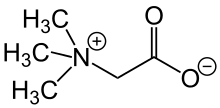Betaine
A betaine (BEET-ah-een, /ˈbiːtɑːˌiːn/) in chemistry is any neutral chemical compound with a positively charged cationic functional group such as a quaternary ammonium or phosphonium cation (generally: onium ions) which bears no hydrogen atom and with a negatively charged functional group such as a carboxylate group which may not be adjacent to the cationic site. A betaine thus may be a specific type of zwitterion. Historically the term was reserved for trimethylglycine only. It is used as a medicine as well.
The pronunciation of the compound reflects its origin and first isolation from sugar beets (Beta vulgaris), and does not derive from the Greek letter beta (β). However, it is often pronounced beta-INE or even BEE-tayn.[1]
In biological systems, many naturally occurring betaines serve as organic osmolytes, substances synthesized or taken up from the environment by cells for protection against osmotic stress, drought, high salinity or high temperature. Intracellular accumulation of betaines, non-perturbing to enzyme function, protein structure and membrane integrity, permits water retention in cells, thus protecting from the effects of dehydration. It is also a methyl donor of increasingly recognised significance in biology.
Glycine betaine, the original betaine

The original betaine, N,N,N-trimethylglycine, was named after its discovery in sugar beet (Beta vulgaris) in the 19th century. It is a small N-trimethylated amino acid, existing in zwitterionic form at neutral pH. This substance is now often called glycine betaine to distinguish it from other betaines that are widely distributed in microorganisms, plants and animals.
Commercial uses
Phosphonium betaines are intermediates in the Wittig reaction.
The addition of betaine to polymerase chain reactions improves the amplification of DNA by reducing the formation of secondary structure in GC-rich regions. The addition of betaine has been reported to enhance the specificity of the polymerase chain reaction by eliminating the base pair composition dependence of DNA melting.[2][3]
See also
- Ylide
- Cocamidopropyl betaine
- Osmoprotectants
Further reading
- IUPAC, Compendium of Chemical Terminology, 2nd ed. (the "Gold Book") (1997). Online corrected version: (2006–) "betaines".
References
- ↑ Alex Nickon and Ernest F. Silversmith (1987). Organic Chemistry, the Name Game: Modern Coined Terms and Their Origins. Pergamon. ISBN 978-0080344812.
- ↑ Rees, William A.; Yager, Thomas D.; Korte, John; Von Hippel, Peter H. (1993). "Betaine can eliminate the base pair composition dependence of DNA melting". Biochemistry 32 (1): 137–44. doi:10.1021/bi00052a019. PMID 8418834.
- ↑ Henke, W; Herdel, K; Jung, K; Schnorr, D; Loening, SA (1997). "Betaine improves the PCR amplification of GC-rich DNA sequences". Nucleic Acids Research 25 (19): 3957–8. doi:10.1093/nar/25.19.3957. PMC 146979. PMID 9380524.